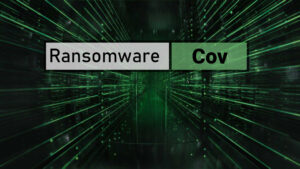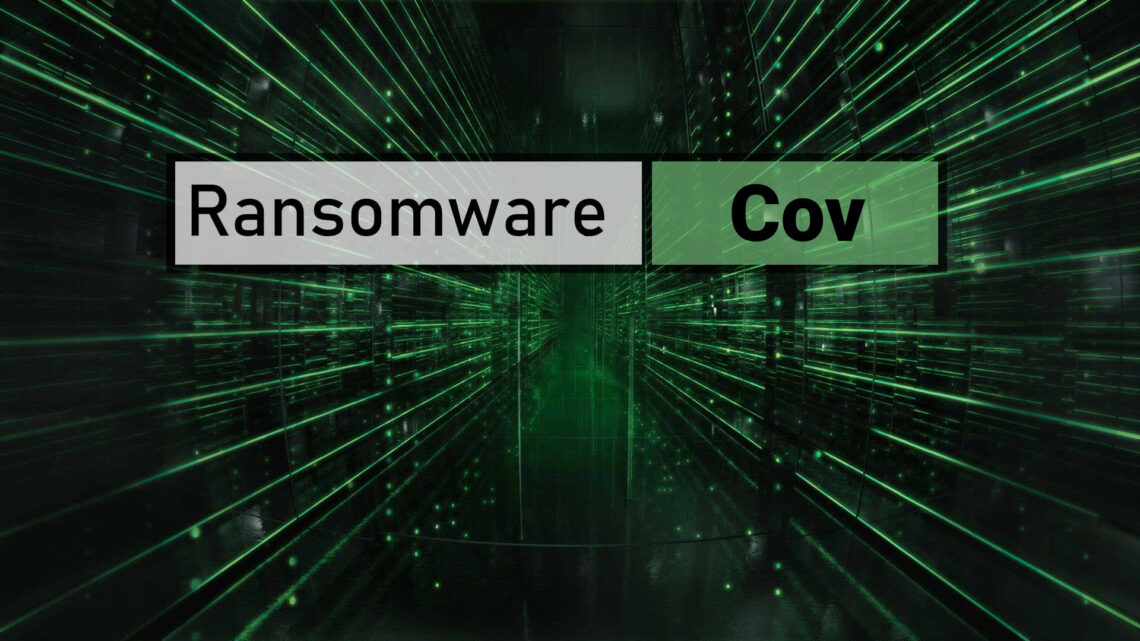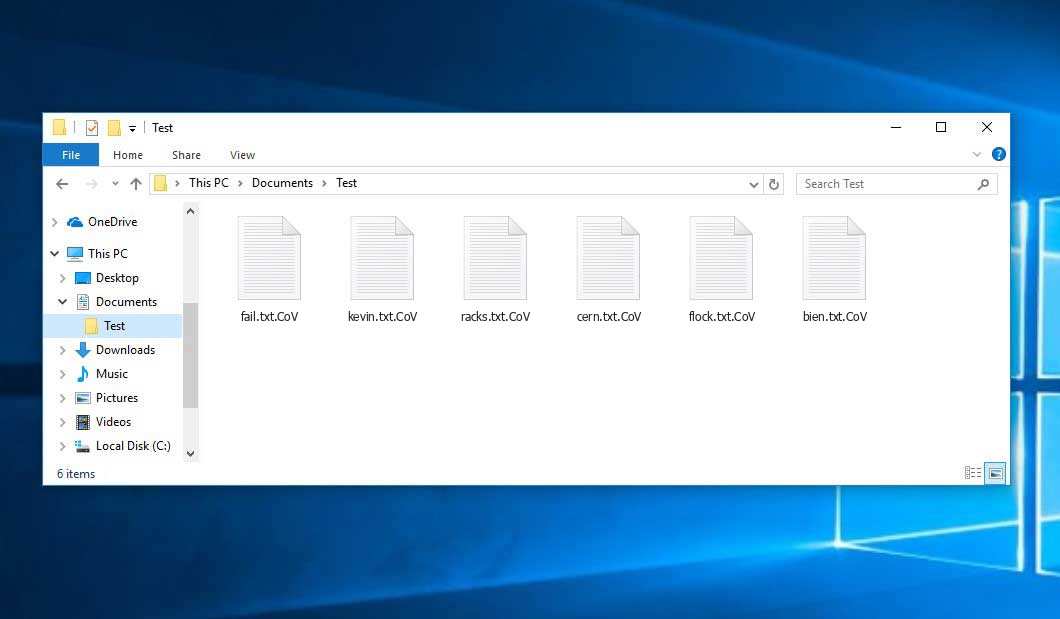The Cov virus belongs to the Xorist ransomware family. A harmful program of such sort encrypts all the data on your computer (photos, text files, excel tables, music, videos, etc) and appends its specific extension to every file, leaving the HOW TO DECRYPT FILES.txt files in each folder containing encrypted files.
What is Cov virus?
☝️ Cov is a Xorist family ransomware-type virus.
Cov will append its own .CoV extension to every file’s title. For example, a file named “photo.jpg” will be altered to “photo.jpg.CoV”. Just like the Excel table named “table.xlsx” will become “table.xlsx.CoV”, and so on.
In every directory containing the encrypted files, a HOW TO DECRYPT FILES.txt file will be created. It is a ransom money memo. It contains information on the ways of paying the ransom and some other information. The ransom note usually contains instructions on how to purchase the decryption tool from the racketeers. You can get this decryptor after contacting [email protected] by email. That is how they do it.
Cov Summary:
| Name | Cov Virus |
| Ransomware family1 | Xorist ransomware |
| Extension | .CoV |
| Ransomware note | HOW TO DECRYPT FILES.txt |
| Ransom | 0.03 BTC |
| Contact | [email protected] |
| Detection | Ransom:Win32/GandCrab!pz, Win32/Injector.CWKU, Ransom:Win32/Egregor.UX!MTB |
| Symptoms | Your files (photos, videos, documents) get a .CoV extension and you can’t open them. |
| Fix Tool | See If Your System Has Been Affected by Cov virus |
The HOW TO DECRYPT FILES.txt file coming in package with the Cov malware provides the following dispiriting information:
Hello, All your important files are encrypted if you want to decrypt them you have to pay me 0.03 bitcoin Make sure you send 0.03 bitcoin to this address: bc1qvxl7lc9kehsh3y3m2aatekpyjs8pd2zx3j34dx If you do not own bitcoins, buy from here: www.paxful.com You can find a larger list here: hxxps://bitcoin.org/en/exchanges After sending the bitcoin, contact me at this email addresses: [email protected] or [email protected] with this subject: - After payment confirmation, I will send you your server keys and decryptor to decrypt your files automatically. You will also receive information on how to resolve your security issue to avoid becoming a victim of ransomware again. From this moment you have 3 days to contact me to make the payment, otherwise I will delete the keys, and be sure that no one will be able to decrypt your files without the original keys, you can try but you will lose your time and your files.
In the picture below, you can see what a folder with files encrypted by the Cov looks like. Each filename has the “.CoV” extension added to it.
How did my computer get infected with Cov ransomware?
There are plenty of possible ways of ransomware infiltration.
Nowadays, there are three most popular ways for tamperers to have ransomware planted in your digital environment. These are email spam, Trojan infiltration and peer-to-peer networks.
- If you access your inbox and see emails that look just like notifications from utility services providers, delivery agencies like FedEx, web-access providers, and whatnot, but whose mailer is unknown to you, be wary of opening those letters. They are most likely to have a malware item attached to them. Therefore, it is even more dangerous to open any attachments that come with emails like these.
- Another thing the hackers might try is a Trojan virus scheme. A Trojan is an object that gets into your computer pretending to be something different. For instance, you download an installer for some program you want or an update for some software. But what is unboxed reveals itself a harmful program that compromises your data. As the update wizard can have any title and any icon, you have to make sure that you can trust the resource of the files you’re downloading. The best thing is to trust the software developers’ official websites.
- As for the peer file transfer protocols like torrent trackers or eMule, the threat is that they are even more trust-based than the rest of the Web. You can never guess what you download until you get it. So you’d better be using trustworthy resources. Also, it is reasonable to scan the directory containing the downloaded items with the anti-malware utility as soon as the downloading is complete.
How to remove ransomware?
It is crucial to note that besides encrypting your files, the Cov virus will probably deploy Vidar Stealer on your computer to seize your credentials to various accounts (including cryptocurrency wallets). The mentioned spyware can extract your credentials from your browser’s auto-filling cardfile.
Remove Cov with Gridinsoft Anti-Malware
We have also been using this software on our systems ever since, and it has always been successful in detecting viruses. It has blocked the most common Ransomware as shown from our tests with the software, and we assure you that it can remove Cov as well as other malware hiding on your computer.

To use Gridinsoft for remove malicious threats, follow the steps below:
1. Begin by downloading Gridinsoft Anti-Malware, accessible via the blue button below or directly from the official website gridinsoft.com.
2.Once the Gridinsoft setup file (setup-gridinsoft-fix.exe) is downloaded, execute it by clicking on the file.

3.Follow the installation setup wizard's instructions diligently.

4. Access the "Scan Tab" on the application's start screen and launch a comprehensive "Full Scan" to examine your entire computer. This inclusive scan encompasses the memory, startup items, the registry, services, drivers, and all files, ensuring that it detects malware hidden in all possible locations.

Be patient, as the scan duration depends on the number of files and your computer's hardware capabilities. Use this time to relax or attend to other tasks.
5. Upon completion, Anti-Malware will present a detailed report containing all the detected malicious items and threats on your PC.

6. Select all the identified items from the report and confidently click the "Clean Now" button. This action will safely remove the malicious files from your computer, transferring them to the secure quarantine zone of the anti-malware program to prevent any further harmful actions.

8. If prompted, restart your computer to finalize the full system scan procedure. This step is crucial to ensure thorough removal of any remaining threats. After the restart, Gridinsoft Anti-Malware will open and display a message confirming the completion of the scan.
Remember Gridinsoft offers a 6-day free trial. This means you can take advantage of the trial period at no cost to experience the full benefits of the software and prevent any future malware infections on your system. Embrace this opportunity to fortify your computer's security without any financial commitment.
Trojan Killer for “Cov” removal on locked PC
In situations where it becomes impossible to download antivirus applications directly onto the infected computer due to malware blocking access to websites, an alternative solution is to utilize the Trojan Killer application.

There is a really little number of security tools that are able to be set up on the USB drives, and antiviruses that can do so in most cases require to obtain quite an expensive license. For this instance, I can recommend you to use another solution of GridinSoft - Trojan Killer Portable. It has a 14-days cost-free trial mode that offers the entire features of the paid version. This term will definitely be 100% enough to wipe malware out.
Trojan Killer is a valuable tool in your cybersecurity arsenal, helping you to effectively remove malware from infected computers. Now, we will walk you through the process of using Trojan Killer from a USB flash drive to scan and remove malware on an infected PC. Remember, always obtain permission to scan and remove malware from a computer that you do not own.
Step 1: Download & Install Trojan Killer on a Clean Computer:
1. Go to the official GridinSoft website (gridinsoft.com) and download Trojan Killer to a computer that is not infected.

2. Insert a USB flash drive into this computer.
3. Install Trojan Killer to the "removable drive" following the on-screen instructions.

4. Once the installation is complete, launch Trojan Killer.
Step 2: Update Signature Databases:
5. After launching Trojan Killer, ensure that your computer is connected to the Internet.
6. Click "Update" icon to download the latest signature databases, which will ensure the tool can detect the most recent threats.

Step 3: Scan the Infected PC:
7. Safely eject the USB flash drive from the clean computer.
8. Boot the infected computer to the Safe Mode.
9. Insert the USB flash drive.
10. Run tk.exe
11. Once the program is open, click on "Full Scan" to begin the malware scanning process.

Step 4: Remove Found Threats:
12. After the scan is complete, Trojan Killer will display a list of detected threats.

13. Click on "Cure PC!" to remove the identified malware from the infected PC.
14. Follow any additional on-screen prompts to complete the removal process.

Step 5: Restart Your Computer:
15. Once the threats are removed, click on "Restart PC" to reboot your computer.
16. Remove the USB flash drive from the infected computer.
Congratulations on effectively removing Cov and the concealed threats from your computer! You can now have peace of mind, knowing that they won't resurface again. Thanks to Gridinsoft's capabilities and commitment to cybersecurity, your system is now protected.
Often racketeers would decode some of your files to prove that they indeed have the decryption tool. As Cov virus is a relatively new ransomware, safety measures engineers have not yet found a way to undo its work. However, the decryption instruments are constantly upgraded, so the effective countermeasure may soon arrive.
Of course, if the evildoers succeed in encoding victim’s critical files, the hopeless person will most likely fulfill their demands. Nevertheless, paying to racketeers does not necessarily mean that you’re getting your blocked information back. It is still risky. After receiving the ransom, the racketeers may send a wrong decryption key to the victim. There were reports of malefactors simply vanishing after getting the money without even bothering to reply.
The optimal solution against ransomware is to have a system restore point or the copies of your essential files in the cloud disk or at least on an external storage. Surely, that might be insufficient. Your most crucial thing could be that one you were working on when it all went down. Nevertheless, it is something. It is also reasonable to scan your drives with the antivirus program after the system is rolled back.
There are other ransomware products, besides Cov, that work similarly. Examples of those are Aer, Cookieshelper, Pings, and some others. The two major differences between them and the Cov are the ransom amount and the encoding method. The rest is the same: documents become encoded, their extensions changed, ransom notes emerge in each directory containing encoded files.
Some lucky victims were able to decode the arrested files with the aid of the free tools provided by anti-malware specialists. Sometimes the criminals mistakenly send the decoding code to the wronged in the ransom readme. Such an epic fail allows the victim to restore the files. But obviously, one should never expect such a chance. Remember, ransomware is a tamperers’ instrument to lay their hands on the money of their victims.
How сan I avoid ransomware injection?
Cov ransomware has no endless power, neither does any similar malware.
You can armour your system from ransomware injection in several easy steps:
- Ignore any emails from unknown mailers with unknown addresses, or with content that has likely no connection to something you are expecting (can you win in a money prize draw without participating in it?). In case the email subject is more or less something you are expecting, check all elements of the suspicious email carefully. A hoax letter will always have a mistake.
- Never use cracked or unknown programs. Trojan viruses are often shared as an element of cracked software, most likely as a “patch” which prevents the license check. But dubious programs are very hard to tell from reliable ones, because trojans may also have the functionality you seek. You can try searching for information on this software product on the anti-malware forums, but the best way is not to use such programs at all.
- And to be sure about the safety of the objects you downloaded, check them with GridinSoft Anti-Malware. This program will be a powerful defense for your PC.
Frequently Asked Questions
🤔 How can I open “.CoV” files?Can I somehow access “.CoV” files?
Unfortunately, no. You need to decipher the “.CoV” files first. Then you will be able to open them.
🤔 The encrypted files are very important to me. How can I decrypt them quickly?
Hopefully, you have made a copy of those important files. Otherwise, you might try to employ System Restore. The only question is whether you have saved any Restore Points that would be helpful now. The rest of the methods require patience.
🤔 Will GridinSoft Anti-Malware remove all the encrypted files alongside the Cov virus?
Absolutely not! Your encrypted files are no threat to your PC.
GridinSoft Anti-Malware will remove the malware from your computer. The ransomware that has infiltrated your system is must be still functional and it scans your system from time to time to encode any new files you might create on your computer after the attack. As it has been said above, the Cov virus comes with the company. It installs backdoors and keyloggers that can steal your account credentials and provide hackers with easy access to your computer in the future.
🤔 What to do if the Cov virus has blocked my PC and I can’t get the activation key.
In such a case, you need to have a flash memory drive with a pre-installed Trojan Killer. Use Safe Mode to perform the cleaning. You see, the ransomware runs automatically as the system boots and encrypts any new files created or imported into your machine. To block this process – use Safe Mode, which allows only the vital programs to run upon system boot. Consider reading our manual on booting Windows in Safe Mode.
🤔 What can I do right now?
Many of the blocked files might still be within your reach
- If you sent or received your critical files through email, you could still download them from your online mailbox.
- You may have shared images or videos with your friends or family members. Just ask them to send those images back to you.
- If you have initially got any of your files from the Internet, you can try to do it again.
- Your messengers, social networks pages, and cloud drives might have all those files too.
- It might be that you still have the needed files on your old PC, a portable device, phone, flash memory, etc.
HINT: You can employ data recovery programs2 to get your lost data back since ransomware arrests the copies of your files, removing the original ones. In the video below, you can see how to use PhotoRec for such a restoration, but remember: you won’t be able to do it before you eradicate the ransomware itself with an antivirus program.
I need your help to share this article.
It is your turn to help other people. I have written this article to help people like you. You can use the buttons below to share this on your favorite social media Facebook, Twitter, or Reddit.
Brendan SmithHow to Remove COV Ransomware & Recover PC

Name: COV Virus
Description: COV Virus is a ransomware-type infections. This virus encrypts important personal files (video, photos, documents). The encrypted files can be tracked by a specific .CoV extension. So, you can't use them at all.
Operating System: Windows
Application Category: Virus



